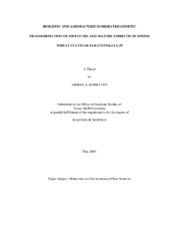| dc.description.abstract | Plant transformation provides a promising methodology of introducing new genes that
encode desirable traits to a wide range of crop plants. Success in genetic transformation
has been achieved in many of the important crop species, such as soybean, cotton, rice,
corn. However, wheat, one of the major crops of the world, has been considered to be
difficult to transform via either Agrobacterium or biolistic bombardment (Rakszegi et
al., 2001). There have been limited studies on A. tumefaciens-mediated transformation of
cereals, including wheat, because of the overall refractory character of host-pathogen
interactions between Agrobacterium and the cereal plants (Gould et al., 1991; Hiei et al.,
1994; Cheng et al., 1997). While the genetic transformation of rice using
Agrobacterium has become routine, only a few successful studies of Agrobacterium-
mediated transformation of wheat have been reported, and these involved a model spring
wheat, Triticum aestivum cultivar Bobwhite (Cheng et al., 1997). Model genotypes are
developed for ease of plant regeneration in tissue culture and both Agrobacterium and
biolistic mediated transformation methods require regeneration of plants in tissue
culture. More success has been achieved in obtaining fertile transgenic wheat plants by
particle bombardment, or biolistics method (Vasil et al., 1992; Weeks et al., 1993;
Becker et al., 1994; Zhou et al., 1995; Altpeter et al., 1996). Wheat plants of the model
system cultivar Bobwhite were used in most of these studies as well. The primary objective of this study was to use the callus-based transformation procedures mentioned above with a non-model cultivar of hexaploid spring wheat Saratovskaya-29, widely grown in Kazakhstan, to test the genotype dependence of the previously developed transformation protocols with respect to stable transfer of DNA and regeneration of transgenic plants. The spring wheat cultivar Saratovskaya-29 (Albidum-24/ Lutescens-55-11) was chosen for the study as being one of the most widely grown wheat cultivars both in Russia and Kazakhstan. It was bred in early 50??s in the Research Institute of the South-East, Saratov. Because of its drought resistance and good baking quality traits, Saratovskaya-29 reached a peak of nearly 21.2 mln ha in the former USSR in 1996 (Martynov and Dobrotvorskaya, 1996). Economical importance of this cultivar makes it an appropriate candidate for further improvement of economically significant traits. Another objective of the study described was to compare the transformation efficiencies and inheritance in the transgenic plants produced. | en |


